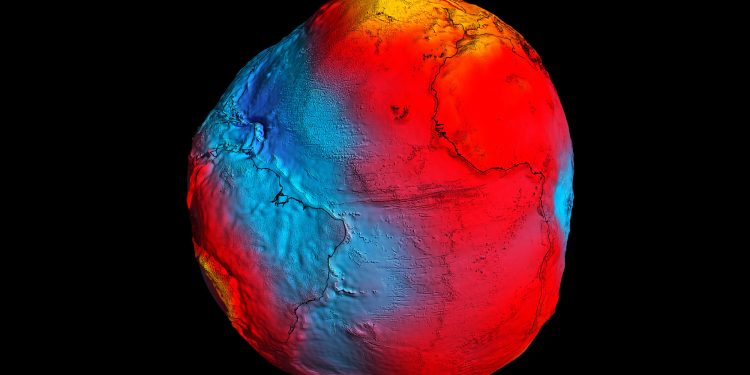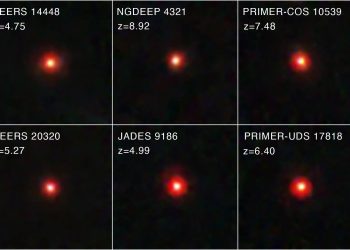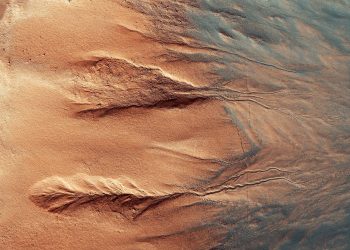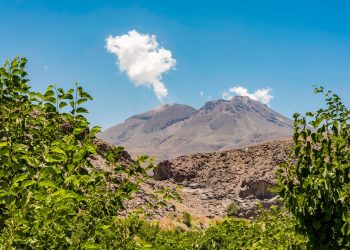The Earth carries an invisible ocean “water level” called a geoid. If only gravity and rotation shaped the oceans, the surface would correspond to this geoid everywhere. However, to the south of India, the geoid is sinking significantly.
At the center of this sunken formation, the geoid lies about 330 feet (100 meters) below the global average, a dramatic signal known as the Indian Ocean Geoid Low (IOGL).
This region of low water raises a clear question: What underground forces could dig such a deep “gravity hole” while leaving a normal-appearing seafloor?
The entity lies in the ocean basin with no obvious scars. This indicates changes in the planet’s interior rather than in the crust. The puzzle focuses on how the mass moved and settled in the mantle over long periods of time.
Study of the Indian Ocean geoid depression
According to the study’s lead author, Debanjan Pal, a doctoral student at the Indian Institute of Science (IISc), IOGL was discovered in 1948 during a gravity study carried out by Dutch geophysicist Felix Andries Vening Meinesz.
However, the cause of this phenomenon was not known until the completion of this study.
The authors of the new study constructed computer simulations of mantle flow covering roughly the last 140 million years.
They fed on reconstructions of plate movements, let old ocean plates sink, let warmer, lighter upwellings rise, and calculated how these mass changes pulled on gravity.
They aimed to match the size and contours of the Indian Ocean geoid depression using a realistic reconstruction of Earth’s history rather than a single snapshot.
The simulations that best reproduced the dip included plumes that rose high – all the way to the middle of the mantle – so their buoyancy could strongly impact the gravity field at the surface.
This result relates a specific vertical reach of the plumes to the strength of the anomaly.
What does an ocean geoid depression mean?
Gravity becomes stronger where extra mass is below you and weakens where less dense material is below.
The Indian Ocean geoid depression is considered the largest negative gravity anomaly on Earth, which is why the “footprint” appears on maps.
Satellites track small changes in their orbits caused by gravity and use these changes to plot the ups and downs of the geoid with great precision. The seabed there appears ordinary, so the signal points deeper.
In a perfect world without winds, currents or tides, the ocean surface would align with the geoid. Above the geoid depression, this surface would be well below the global average.
In the real ocean, circulation blurs the image, but the negative signal from the geoid remains strong – the “gravity hole” measured today.
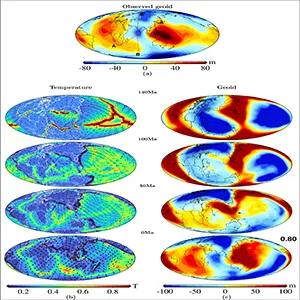
Deep mantle under Africa-Indian Ocean
The models trace the history of the Tethys Ocean, the body of water that once stretched between India and Eurasia.
As oceanic crust dipped into subduction zones, its cold, dense plates dipped and piled up near the margin of a warm, low-density region in the deep mantle beneath Africa.
Geophysicists often call this warm region a “large low-shear velocity province,” where seismic waves propagate more slowly because the mantle is hotter and less dense.
This broad configuration is important. The sinking slabs pressed against the deep structure beneath Africa and helped spawn buoyant plumes that drifted east and upward beneath the Indian Ocean.
Together, the heavy slabs and lighter plumes rearranged themselves where mass is located inside the Earth. This reshaped the gravity field in a way that matches the scale and contours of the current Indian Ocean geoid depression.
A timing that corresponds to the history of the Earth
Computer simulations suggest that the first plumes capable of shaping the geoid depression rose about 20 million years ago.
This lag follows the path one would expect: the slabs need time to descend into the lower mantle, interact with the warm African province and establish regular upwellings.
India’s rapid northward movement across the ocean and its ultimate collision with Asia set the chain in motion, fueling subduction over tens of millions of years.
Not all models agree
Previous work, focusing only on current mantle structure, suggested that warm anomalies in the middle and upper mantle were important, but left the origin of this pattern unclear. Some “snapshot” models have placed the cause just below the geoid depression.
The new results show a different pathway: an evolutionary interaction between long-lived plates and the warm, deep mantle beneath Africa that ultimately organized plumes toward the Indian Ocean and produced the observed depression.
Researchers combine three data sources to study the hidden structure of the mantle. Gravitational data reveals where mass is high or low.
Seismic waves from earthquakes sweep across the interior; Slower waves highlight warmer, lower-density regions, while faster waves highlight colder, denser patches.
Geodynamic models test whether a proposed interior design and history can produce the same gravitational signal observed on the surface.
When all three agree on a model, one is more confident that the inner picture is on the right track.
More Questions Need Answers
Clearer images of the mantle beneath the Indian Ocean would be helpful.
Denser coverage of seismic stations and more earthquake records throughout the region can refine the depth and shape of plumes and the boundaries of the deep African province.
With better coverage, modelers can tighten the link between the peak of upwellings and their impact on the geoid.
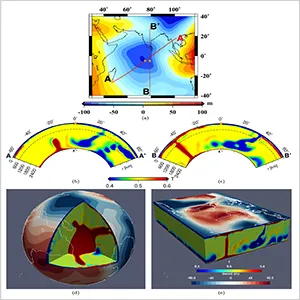
Why the Indian Ocean geoid is important
This work connects surface plate movements, deep mantle circulation, and modern gravitational measurements into a single coherent picture.
It explains why an area of normal-looking seafloor lies above the planet’s deepest geoid dip and shows how mass movements over long periods of time produce the signal satellites see today.
The chain extends from ancient oceanic crust sinking into the mantle to upwellings of warm water pushed eastward to a gravitational signature that stands out in the ocean “level” today.
The full study was published in the journal Geophysical research letters.
—–
Do you like what you read? Subscribe to our newsletter for engaging articles, exclusive content and the latest updates.
Check us out on EarthSnap, a free app brought to you by Eric Ralls and Earth.com.
—–


